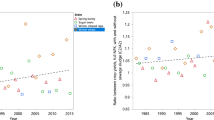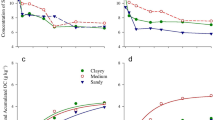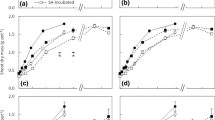Abstract
Two field experiments were conducted to compare the fertilizing and liming properties of dried lime-treated sewage sludge with its incineration product (ash). One experiment used a mixture of ryecorn and ryegrass on a relatively fertile soil and the other lucerne on a strongly acidic and phosphorus deficient soil.
The first harvest of the ryecorn-ryegrass experiment showed small but significant linear responses in dry matter yield to both ash and sludge. Ash applications did not affect foliage nitrogen and phosphorus concentrations, or uptakes, but sludge applications increased these significantly. Sludge also increased the concentrations of K, S, Mg, Cu and Zn but ash only increased the concentrations of S and Mg. At the second harvest (ryegrass) 5 t ha−1 of sludge increased dry matter yield and foliage nitrogen and phosphorus concentrations whereas ash had no effect. Levels of phosphorus extracted from the soil were increased by both amendments but the sludge was much more effective than the ash. Both ash and sludge raised soil pH.
In the lucerne experiment comparisons between sludge and ash were calculated from response surfaces fitted to the data which showed marked increased in soil pH and dry matter yield. Sludge markedly increased extractable phosphorus whereas ash had no effect. The sludge was 22% as effective as ash in raising soil pH to 6.5. The amounts of ash required to obtain the same yield as 10 t ha−1 of sludge were 5.78, 12.78 and 6.39 t ha−1 respectively for three successive harvests. These results and those for foliage concentrations of nitrogen and phosphorus were also ascribed to the much greater availability of the sludge phosphorus than the ash phosphorus, and the presence of nitrogen in the sludge but not in the ash.
Similar content being viewed by others

References
Chapman HD (1966) Diagnostic Criteria for Plants and Soils, Univ California
Chapman HD and Pratt PF (1961) Methods for Analysis of Soils, Plants and Waters, Univ California
Coker EG (1966) The value of liquid digested sewage sludge, I J Agric Sci (Camb) 67, 91–97
Coker EG (1966) The value of liquid digested sewage sludge, II. J Agric Sci (Camb) 67, 99–103
Coker EG (1983) Biological aspects of the disposal-utilization of sewage sludge on land. Adv Appl Biol 9, 257–322
Colwell JD (1963) The estimation of the fertilizer requirements of wheat in New South Wales by soil analysis. Aust J Exp Ag An Husb 3, 190–197
Colwell JD (1969) Autoanalyser procedure for organic carbon analysis. National Soil Fertility Project, Circ No 54
Gestring WD and Jarrell WM (1982) Plant availability of phosphorus and heavy metals in soils amended with chemically treated sewage sludge. J Environ Qual 11, 669–675
Kirkham MB (1982) Agricultural use of phosphorus in sewage sludge. Adv Agron 35, 129–163
Loveday J and Reeve R (1974) Carbonate determination. In J Loveday (ed) Methods for the analysis of irrigated soils. Commonwealth Agricultural Bureau, Farnham Royal, UK
Mellbye ME, Hemphill DD and Volk VV (1982) Sweet corn growth on incinerated sewage sludge-amended soil. J Environ Qual 11, 160–163
O'Neill J and Webb RA (1970) Simultaneous determination of nitrogen, phosphorus and potassium in plant materials by automatic methods. J Sci Food Agric 21, 217–219
Soil Survey Staff (1975) Soil Taxonomy. USDA Handbook 436 US Government Printing Office, Washington, USA
Soon YK, Bates TE, Beauchamp EG and Moyer JR (1978) Land application of chemically treated sewage sludge, I J Environ Qual 7, 264–269
Soon YK, Bates TE and Moyer JR (1978) Land application of chemically treated sewage sludge, II. J. Environ. Qual 7, 269–273
Soon YK, Bates TE and Moyer JR (1980) Land application of chemically treated sewage sludge, III. J Environ Qual 9, 497–504
Stace HCT, Hubble GD, Brewer R, Northcote KH, Sleeman JR, Mulchy MJ and Hallsworth EG (1968) A Handbook of Australian Soils, Rellim, South Australia
Willett IR, Jakobsen P and Malafant KWJ (1986) Fertilizing and liming value of lime-treated sewage sludge. Fert Res 8, 313–328
Willett IR, Jakobsen P, Cunningham RB and Gunthorpe JR (1984) Effects of lime-treated sewage sludge on soil properties and plant growth, Report for 1981–1982. CSIRO, Australia, Div Soils Div Rep 67
Zarcinas BA (1984) Analysis of soil and plant materials by inductively coupled plasma-optical emmision spectrometyr. CSIRO, Australia, Div Soils, Rep 70
Author information
Authors and Affiliations
Rights and permissions
About this article
Cite this article
Jakobsen, P., Willett, I. Comparisons of the fertilizing and liming properties of lime-treated sewage sludge with its incinerated ash. Fertilizer Research 9, 187–197 (1986). https://doi.org/10.1007/BF01050345
Accepted:
Issue Date:
DOI: https://doi.org/10.1007/BF01050345



